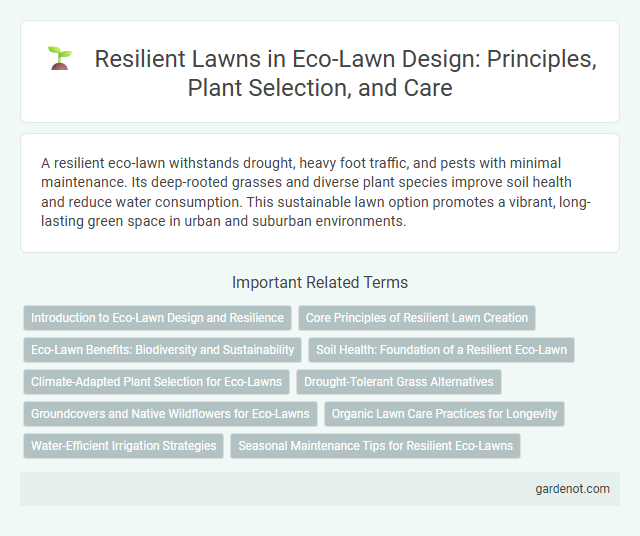A resilient eco-lawn withstands drought, heavy foot traffic, and pests with minimal maintenance. Its deep-rooted grasses and diverse plant species improve soil health and reduce water consumption. This sustainable lawn option promotes a vibrant, long-lasting green space in urban and suburban environments.
Introduction to Eco-Lawn Design and Resilience
Eco-lawn design emphasizes drought-tolerant grasses and native plants that create a resilient lawn capable of withstanding environmental stressors such as heat, pests, and soil erosion. Incorporating deep-rooted species enhances water retention and nutrient cycling, promoting sustainable growth with minimal maintenance. This resilience reduces reliance on chemical fertilizers and frequent irrigation, fostering an eco-friendly lawn ecosystem.
Core Principles of Resilient Lawn Creation
A resilient lawn thrives through core principles such as selecting drought-tolerant grass species, implementing deep and infrequent watering techniques, and promoting soil health with organic amendments and proper aeration. Emphasizing biodiversity by incorporating native plants enhances ecosystem stability and reduces pest susceptibility. Regular maintenance practices, including mowing at optimal heights and minimizing chemical inputs, support long-term lawn durability and environmental sustainability.
Eco-Lawn Benefits: Biodiversity and Sustainability
Eco-lawns enhance biodiversity by providing habitat for pollinators and supporting native plant species, which strengthens local ecosystems. Their drought-resistant grasses reduce water consumption, promoting sustainability and lowering maintenance costs. These resilient lawns improve soil health through natural processes, contributing to long-term environmental benefits.
Soil Health: Foundation of a Resilient Eco-Lawn
Healthy soil rich in organic matter and beneficial microorganisms forms the foundation of a resilient eco-lawn by enhancing nutrient retention and water infiltration. Maintaining balanced soil pH and structure supports robust grass root systems that resist drought and pest damage. Regularly incorporating compost and minimizing chemical use promotes soil biodiversity, crucial for long-term lawn durability and sustainability.
Climate-Adapted Plant Selection for Eco-Lawns
Resilient eco-lawns thrive through climate-adapted plant selection, emphasizing drought-tolerant grasses like Buffalo grass and native fescues that withstand heat and water scarcity. Choosing species with deep root systems enhances soil stability, reduces erosion, and lowers irrigation needs. Integrating climate-resilient plants improves lawn sustainability, biodiversity, and overall ecological function in varying environmental conditions.
Drought-Tolerant Grass Alternatives
Drought-tolerant grass alternatives such as buffalo grass, Bermuda grass, and fescue varieties are key components of resilient eco-lawns, requiring significantly less water than traditional turf. These grasses maintain their green appearance during dry periods due to deep root systems that efficiently access soil moisture. Incorporating drought-resistant species promotes sustainability by reducing irrigation needs and enhancing a lawn's ability to withstand climate variability.
Groundcovers and Native Wildflowers for Eco-Lawns
Groundcovers and native wildflowers create a resilient lawn ecosystem by enhancing soil health and biodiversity while reducing water use and maintenance needs. These plants establish deep root systems that improve drought tolerance and prevent soil erosion, supporting a sustainable and low-impact eco-lawn. Incorporating native species promotes local wildlife habitats, attracting pollinators and beneficial insects essential for a balanced landscape.
Organic Lawn Care Practices for Longevity
Resilient lawns thrive through organic lawn care practices that enhance soil health and promote natural pest resistance, reducing the need for chemical inputs. Techniques such as composting, mulching, and the use of natural fertilizers improve nutrient cycling, water retention, and microbial activity essential for long-term sustainability. Emphasizing native grass species and regular aeration strengthens root systems, ensuring a durable and eco-friendly lawn environment.
Water-Efficient Irrigation Strategies
Resilient lawns benefit significantly from water-efficient irrigation strategies that optimize moisture retention and reduce water waste. Techniques such as drip irrigation, smart controllers, and soil moisture sensors ensure targeted watering, promoting deep root growth and drought tolerance in grass species like fescue and buffalo grass. Implementing these practices conserves water resources while maintaining a lush, healthy eco-lawn.
Seasonal Maintenance Tips for Resilient Eco-Lawns
Seasonal maintenance for resilient eco-lawns includes regular mowing at optimal heights, typically 2 to 3 inches, to promote deep root growth and drought resistance. Applying organic fertilizers in early spring and late fall supports natural soil health and nutrient cycling. Aerating the soil during autumn enhances water infiltration and root development, crucial for maintaining a robust, eco-friendly lawn throughout varying weather conditions.
Resilient lawn Infographic

 gardenot.com
gardenot.com